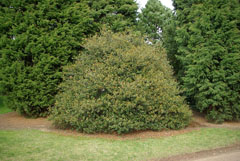 |
|
http://www.flickr.com/people/44124284226@N01 |
 |
| http://commons.wikimedia.org/wiki/User:Nick |
Translate this page:
Summary
Physical Characteristics

 Chrysolepis chrysophylla is an evergreen Tree growing to 20 m (65ft 7in) at a medium rate.
Chrysolepis chrysophylla is an evergreen Tree growing to 20 m (65ft 7in) at a medium rate.
See above for USDA hardiness. It is hardy to UK zone 7. It is in leaf all year, in flower in July. The species is monoecious (individual flowers are either male or female, but both sexes can be found on the same plant) and is pollinated by Wind, midges.
Suitable for: light (sandy) and medium (loamy) soils and prefers well-drained soil. Suitable pH: mildly acid and neutral soils and can grow in very acid soils.
It can grow in semi-shade (light woodland). It prefers moist soil.
UK Hardiness Map
US Hardiness Map
Synonyms
Castanea chrysophylla. Castanopsis chrysophylla.
Plant Habitats
Woodland Garden Canopy; Secondary;
Edible Uses
Edible Parts: Seed
Edible Uses:
Seed - raw or cooked[22, 46]. Very sweet and much appreciated[63, 71, 82, 105, 183]. The seed can also be dried, ground into a powder and used as a thickening in soups, mixed with cereals when making bread etc[257]. The seed is about 1cm long and has a hard shell[183].
References More on Edible Uses
Medicinal Uses
Plants For A Future can not take any responsibility for any adverse effects from the use of plants. Always seek advice from a professional before using a plant medicinally.
None known
References More on Medicinal Uses
The Bookshop: Edible Plant Books
Our Latest books on Perennial Plants For Food Forests and Permaculture Gardens in paperback or digital formats.

Edible Tropical Plants
Food Forest Plants for Hotter Conditions: 250+ Plants For Tropical Food Forests & Permaculture Gardens.
More

Edible Temperate Plants
Plants for Your Food Forest: 500 Plants for Temperate Food Forests & Permaculture Gardens.
More

More Books
PFAF have eight books available in paperback and digital formats. Browse the shop for more information.
Shop Now
Other Uses
Wood
Wood - fine-grained, light, soft, not strong. Occasionally used for making ploughs and other agricultural implements, and also as a fuel[46, 61, 82, 229].
Special Uses
Scented Plants
References More on Other Uses
Cultivation details
Requires a lime-free soil[1]. Prefers a sheltered semi-shaded position and a light deep moist soil[1, 11]. A very ornamental tree[183], it is slow to moderate growing and can live 400 - 500 years in the wild[229]. One report says that this species only succeeds in Oceanic and Mediterranean climates[200]. This species has a very wide natural range in N. America, seeds should be tried from various provenances to find more suitable selections for Britain[11]. Another report says that the plant is only found in a small area of California and Oregon, but that it grows on a wide range of soil types[229]. There are trees 16 metres tall in Surrey and Buckinghamshire[11], it also fruits in Cornwall[59] and fruits well in addition to self-sowing at Edinburgh botanical gardens[11]. Flowers are produced on the current years growth, the seed taking two summers to mature[229]. The catkins have an unpleasant hawthorn-like smell to attract midges for their pollination[245]. This species resists chestnut blight[200].
References Carbon Farming Information and Carbon Sequestration Information
Temperature Converter
Type a value in the Celsius field to convert the value to Fahrenheit:
Fahrenheit:
The PFAF Bookshop
Plants For A Future have a number of books available in paperback and digital form. Book titles include Edible Plants, Edible Perennials, Edible Trees,Edible Shrubs, Woodland Gardening, and Temperate Food Forest Plants. Our new book is Food Forest Plants For Hotter Conditions (Tropical and Sub-Tropical).
Shop Now
Plant Propagation
Seed - best sown in a cold frame as soon as it is ripe, the seed must be protected from mice etc[200]. The seed has a short viability and should not be allowed to dry out. If stored overwinter it should be kept cool and moist. As soon as they are large enough to handle, prick the seedlings out into individual pots and grow them on in a greenhouse for at least their first winter. Plant them out into their permanent positions in late spring or early summer, after the last expected frosts, and consider giving them some protection from the cold for their first winter outdoors.
Other Names
If available other names are mentioned here
Native Range
NORTHERN AMERICA: United States (Oregon, Washington, California)
Weed Potential
Right plant wrong place. We are currently updating this section.
Please note that a plant may be invasive in one area but may not in your area so it's worth checking.
Conservation Status
IUCN Red List of Threatened Plants Status :

Growth: S = slow M = medium F = fast. Soil: L = light (sandy) M = medium H = heavy (clay). pH: A = acid N = neutral B = basic (alkaline). Shade: F = full shade S = semi-shade N = no shade. Moisture: D = dry M = Moist We = wet Wa = water.
Now available:
Food Forest Plants for Mediterranean Conditions
350+ Perennial Plants For Mediterranean and Drier Food Forests and Permaculture Gardens.
[Paperback and eBook]
This is the third in Plants For A Future's series of plant guides for food forests tailored to
specific climate zones. Following volumes on temperate and tropical ecosystems, this book focuses
on species suited to Mediterranean conditions—regions with hot, dry summers and cool, wet winters,
often facing the added challenge of climate change.
Read More
Expert comment
Author
(Douglas. ex Hook.)Hjelmq.
Botanical References
1171200
Links / References
For a list of references used on this page please go here
Readers comment